- Все статьи 658
-
Подпишитесь, чтобы получать уведомления о публикации новых выпусков
International Journal of Information Engineering and Electronic Business @ijieeb
Статьи журнала - International Journal of Information Engineering and Electronic Business
Все статьи: 658
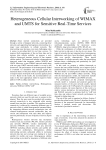
Heterogeneous Cellular Interworking of WIMAX and UMTS for Sensitive Real-Time Services
Mina Malekzadeh
Статья научная
Since internet connections are provided through a variety of disparate networks, connecting these networks and supporting heterogeneous interworking is a major issue particularly in cellular networks. The interworking issue becomes even more challenging when it comes to providing QoS for real time services. To improve QoS requirements of the real time data and to increase inter cellular mobility, we propose a cost-effective framework structure consists of four separate cellular models. The framework includes a heterogeneous interwork model that integrates cellular WiMAX and UMTS. Moreover, a pure WiMAX network model along with two pure UMTS network models is set up by the framework. The performance of the heterogeneous model is evaluated via simulation and analyzed against the measured metrics of the pure models to quantify the level of improvements from QoS of the real time packets point of view. Based on the results, the recommendations are made on the most appropriate model in regard to better QoS for VoIP in cellular networks.
Бесплатно
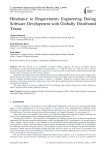
Hindrance to Requirements Engineering During Software Development with Globally Distributed Teams
Waqas Mahmood, Syed Shaharyar Rizvi, Siraj Munir
Статья научная
With the increase in the availability of skilled software engineers, the process of global software development is being increasingly adopted by organizations, at a relatively lesser cost. This has led to software processes being more viable in a progressive manner for several reasons that include better communication technologies and the levels of maturity seen in the software industry. That being said, Organizations that undertake the decision of adopting Global software development should realize that this process isn't exactly a risk-free action and there have been many failures reported with regard to it. The existing bools of globally distributed projects portray a number of challenges. During the interactive phase, the need for particular consideration towards the requirements of the client and the globally dispersed distributed software provider teams has been indicated. This paper makes use of surveys collected from IT professionals and people working in the software industry in order to present realistic insights gathered from them.
Бесплатно
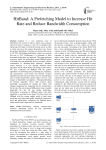
HitBand: A Prefetching Model to Increase Hit Rate and Reduce Bandwidth Consumption
Islam Anik, Akter Arifa, Hamid Md. Abdul
Статья научная
Caching is a very important issue in distributed web system in order to reduce access latency and server load. A request is a hit if it is available in the cache and if not then it will fetch from the server in order to cache and serve the request. Researches have shown that generic algorithms of caching can increase hit rate up to 40−50%, but adding prefetching scheme can increase this rate to 20%. Prefetching is a technique to fetch documents before they are requested. This paper proposes a process model for prefetching named HitBand which will balance hit rate bandwidth in every scenario with the combination of "Roulette-wheel selection". Roulette-wheel selection is a very popular selection based algorithm which selects objects according to their fitness. We have compared our HitBand with the generic algorithms of prefetching like prefetching by popularity, apl characteristic, good Fetch and lifetime. Generic algorithms did not take web object size into consideration and in limited bandwidth scenario object size has a big impact on bandwidth consumption. Though prefetching by lifetime algorithm shows little concern about bandwidth consumption by getting the object with changes happening less frequently but this compromises the hit rate. But our proposed HitBand not only considers bandwidth but also hit rate during prefetching. Performance evaluation of HitBand along with other algorithms is provided in our paper. We have tested our HitBand with the testing engine which is built using JavaScript and maintained under AngularJS framework. From the performance evaluation, our HitBand shows better results both in high and low bandwidth.
Бесплатно

House Price Prediction Modeling Using Machine Learning
M. Thamarai, S. P. Malarvizhi
Статья научная
Machine Learning is seeing its growth more rapidly in this decade. Many applications and algorithms evolve in Machine Learning day to day. One such application found in journals is house price prediction. House prices are increasing every year which has necessitated the modeling of house price prediction. These models constructed, help the customers to purchase a house suitable for their need. Proposed work makes use of the attributes or features of the houses such as number of bedrooms available in the house, age of the house, travelling facility from the location, school facility available nearby the houses and Shopping malls available nearby the house location. House availability based on desired features of the house and house price prediction are modeled in the proposed work and the model is constructed for a small town in West Godavari district of Andhrapradesh. The work involves decision tree classification, decision tree regression and multiple linear regression and is implemented using Scikit-Learn Machine Learning Tool.
Бесплатно
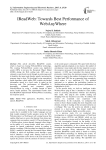
IReadWeb: Towards Best Performance of WebAnyWhere
Najwa K. Bakhsh, Saleh Alshomrani, Imtiaz Hussain Khan
Статья научная
This article describes IReadWeb system, which is based on existing WebAnyWhere technology. The existing WebAnyWhere system uses depth-first search (DFS) to traverse the Document Object Model (DOM) during the Web surfing task. DFS uses an exhaustive search and crawls through an entire page until it identifies the target node thereby greatly increasing the response time to users. We developed a user-experienced based algorithm, which, unlike DFS, exploits pre-fetched information stored in a local cache to speed up the browsing task. The performance of IReadWeb is thoroughly evaluated and compared against WebAnyWhere by using a sizeable sample of blind native Arabic speakers. The experimental results show that IReadWeb outperformed WebAnyWhere in attaining fast response speed.
Бесплатно
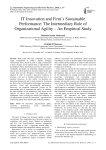
Mohamed Amine Marhraoui, Abdellah El Manouar
Статья научная
Both small and large companies are facing tough competition in today’s rapidly changing environment. They should be able to adapt continuously to these changes and to exploit them as opportunities of development. Firms should then innovate in order to gain sustainable advantage, by proposing adequate products and services allowing them to increase market shares and sustain their growth. Disruptive technologies are thus adopted in order to conceive innovative products, to develop a new use of existing products/services or to optimize processes. In this article, we describe our theoretical framework and its main constructs. It presents the direct effect of information technology innovation on economic, social and environmental performance. Moreover, our proposed framework focuses on the intermediary role of organizational agility. In addition, the main findings of our quantitative study based on the analysis of survey data from 103 participants are highlighted. After verifying the validity and reliability of our questionnaire results, the framework’s hypotheses are tested using partial least squares path modeling method.
Бесплатно
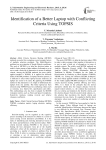
Identification of a Better Laptop with Conflicting Criteria Using TOPSIS
T. Miranda Lakshmi, V. Prasanna Venkatesan, A. Martin
Статья научная
Multi Criteria Decision Making (MCDM) methods are useful for evaluating several complex factors of multiple selection problems. The Multi-Objective problems are an extension of Single-Objective problems. The goal of MCDM is to help the decision maker to make a choice among a finite number of alternatives or to sort or rank a finite set of alternatives in terms of multiple criteria. Among the MCDM methods, the most widely applied method is TOPSIS. It is applied for different kinds of MCDM problems. In laptop selection process, it is difficult to select better laptop because relatively all laptops are seems to be same. By applying the TOPSIS method to the alternatives it is simple to differentiate the laptops from one another. The better laptop has been selected using TOPSIS based on conflicting criteria such as warranty, size, battery life, specification and others. This methodology also has been evaluated by MCDM evaluation metrics such as Time and Space Complexity, Sensitivity Analysis, ranking reversal and relative closeness coefficient.
Бесплатно
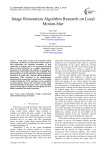
Image Restoration Algorithm Research on Local Motion-blur
Yan Chen, Jin Hua
Статья научная
In this paper, we aim at the restoration of local motion-blur. On the base of construction of basic model of local motion-blur, the formation mechanism of local motion-blur is analyzed, and a new restoration algorithm aimed at local motion-blur in a complex background is proposed. In the algorithm, the problem of restoration of blurred image with complex background is simplified. First, the blurred part is extracted from the complex background, and then it is pasted onto a bottom with monochromatic background. After restoration in the monochromatic background, the restored part is pasted back to the original complex background. All the operations can be completed in spatial domain. Because the restoration of blur image with monochromatic background is easier, so the algorithm proposed in this paper is simple, fast and effectual. It is an effective method of blur image restoration.
Бесплатно
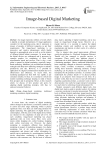
Shyam R. Sihare
Статья научная
An image represents millions of words which is depend on people interpretation. If image application considers for the marketing arena, then it represents to masses of peoples of different categories as per their requirements. The image-based marketing is an innovative and creative phenomenon which highly depends on geographical areas as well as on the interest of different placed habitat consumers. At recent times, the digital devices are widespread and it possesses by common peoples for completion of their daily miscellaneous needs and services. That is why, a new globe is opened for digital marketing, especially image-based marketing. Marketers jolt out traditional marketing strategies and adopt new marketing strategies to enhance productivity and sale. However, it is possible by application of a digital communication medium due to its effectiveness and efficiency. At recent times, the marketing paradigm has been shift very rapidly as per consumer mindset, for that, it is essential to switch into modern marketing technique keeping in mind of future firm prospect and its prosperity. Hence, in this research article, we discuss of how product sale grows by adopting digital marketing strategies, with that, we analyzed consumer behavior.
Бесплатно
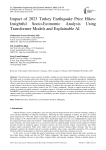
Muhammed Yaseen Morshed Adib, Md. Tauhid Bin Iqbal, Farig Yousuf Sadeque
Статья научная
Natural disasters cause economic instability, leading to severe financial hardships for affected communities. The rapid surge in essential goods prices during such events significantly burdens vulnerable populations, highlighting the critical need for timely policy interventions. While understanding public sentiment on economic distress is crucial for effective data-driven policy generation, research specifically analyzing public sentiment on price hikes in such contexts remains limited, often due to a lack of dedicated datasets. To address this, this paper first introduces a novel dataset of social media comments on price hikes related to the 2023 Turkey earthquake. Second, to support data-driven policy-making by quantifying public sentiment, we applied a range of AI models and identified transformer-based models like DistilBERT as particularly effective for sentiment classification. Furthermore, we employ Explainable AI techniques to enhance model trust, enabling policymakers to confidently use these insights to support disaster recovery and economic stabilization in affected regions.
Бесплатно
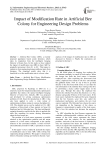
Impact of Modification Rate in Artificial Bee Colony for Engineering Design Problems
Tarun Kumar Sharma, Millie Pant, Deepshikha Bhargava
Статья научная
Artificial Bee Colony (ABC), a recently proposed population based search heuristics which takes its inspiration from the intelligent foraging behavior of honey bees. In this study we have studied the impact of modification rate (MR) in basic ABC by gradually increasing it from 0.1 to 0.9. This impact is studied on four engineering design problems taken from literature. The simulated results show that it is beneficial to set the modification rate to a lower value.
Бесплатно
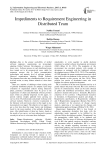
Impediments to Requirement Engineering in Distributed Team
Nabiha Usmani, Rabbia Hassan, Waqas Mahmood
Статья научная
Due to the greater availability of skilled software engineers, organizations are increasingly adopting Global Software Development, at relatively lesser costs. Software process in such distributed teams have turned out to be progressively more viable for numerous reasons, due to better communication technologies and maturity level of software industry. However organizations adopting Global Software Development must take into consideration that it is not a risk-free action, as many failures related to it have been reported. There are a number of challenges when existing tools of globally distributed projects are adopted. Upon deep evaluation of requirement analysis during interactive phase, particular consideration must be given to the requirements of clients and distributed software provider teams which are globally dispersed. In this paper, we present realistic insights gathered from carrying out surveys from IT professionals and people working in the software industry. Moreover, extensive examination of the literature work previously done in this regard is also documented in our paper. The objective of our paper is to get a clear idea about the major factors and challenges faced by the team members of the globally distributed team. After identification of these key factors, based on the results of our survey, we have endeavored to present an analysis on how to overcome these challenges.
Бесплатно
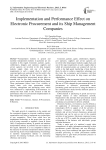
Implementation and Performance Effect on Electronic Procurement and its Ship Management Companies
V.K. Narendira Kumar, B. Srinivasan
Статья научная
Transportation industry in general and maritime transportation industry in particular are not exception in this regard. Customers, partners, agents, collaborators, shippers, port operators, suppliers and service agencies are involved in the ship transport industry supply chain, and one of the major requirements in such a supply chain in which all concerned parties are scattered all over the world, is the high speed transferring of data between them. In maritime transportation procurement process plays an essential role. In this study based on the literature review, seven most frequently mentioned factors found. These performance factors were: Cost, visibility of supply chain, cycle time, procurement control, inventory management and purchasing errors which were influenced by implementing E-Procurement. An attempt has been made in this research to find the performance effect of e-procurement implementation in ship management companies.
Бесплатно
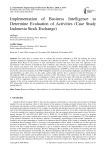
Ali Fajri, Ardiles Sinaga
Статья научная
This study aims to examine how to evaluate the activities undertaken in IDX. By building the system "business intelligence implementation to determine the evaluation of activities ". Where in this study also used the algorithm Naive Bayes in the process of data classification activities that have been done. The approach to the development of this software is through the study of libraries, data collection, system design, system implementation, Test systems and analysis. The tools used in the development of this software are Pentaho, PostgreSQL (as a data processing tool), Microsoft Excel (as a tool for creating training data), XAMPP (as a Web server tool) and the encoding used in this software development is the PHP CodeIgniter framework (as the backend), Highcharts (as Dashboard views) and DataTables (as table views). In this study, authors build software that is expected to help the Directorate of Development (RPE) in conducting evaluation activities in IDX. The analysis of the study uses variables from budget-realization data and activity categories as comparators to figure out the activity status. The study also used IDX activity data in 2018 to implement a built-in system. The results of this study show that the realization of the budget and category of this activity strongly affects the activities that will be evaluated or not evaluated. Activities in each of the IDX representative offices are also potentially to be evaluated, depending on the value of the budget specified in the training data set.
Бесплатно
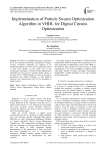
Implementation of Particle Swarm Optimization Algorithm in VHDL for Digital Circuits Optimization
Garima Grover, Ila Chaudhary
Статья научная
In order to accomplish the targets of specified levels for reducing the hardware requirements of digital systems, innovative techniques are required to be implemented either at the device level, architectural level or gate level designs. In this paper one of the evolutionary techniques i.e. Particle Swarm Optimization Algorithm has been used to optimize digital circuits at the gate level on VHDL platform to draw an automatic, generalised and reliable technique to find optimum solutions with reduced gate count for the designing of digital systems.
Бесплатно
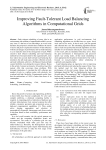
Improving Fault-Tolerant Load Balancing Algorithms in Computational Grids
Jasma Balasangameshwara
Статья научная
Fault tolerant scheduling of many jobs in an environment with millions of unpredictable nodes is not an easy issue. To the best of our knowledge, no work in the literature has proposed a solution that combines the merits of active and passive replication schemes of fault tolerance with the advantages of performance-driven load balancing so as to make the most of the strong points of each. While extensive fault tolerant scheduling and load balancing methods have been presented for the sequential jobs, none have taken into account fault-tolerant load balancing that minimizes the job make-span, provides efficient network and node utilization, achieves a Ill-balanced load and high system flexibility even during the resource failures. Hence, in this article, I present an Adaptive Scheduling Algorithm namely ASA that overcomes these problems. With thorough simulations, I conclude that ASA allocates any number of jobs to a million nodes with relatively low overhead and high flexibility. Experimental results show that the performance of ASA is better than those of its counterparts.
Бесплатно
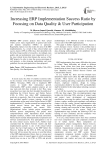
Increasing ERP Implementation Success Ratio by Focusing on Data Quality & User Participation
M. Rizwan Jameel Qureshi, Alnamer M. Abdulkhalaq
Статья научная
ERP systems projects have been spread widely across many organizations in general and small and medium enterprises (SMEs) in particular. Regrettably, failures were the results for most of the ERP implementations. As a result of that, critical failure and success factors (CFFs & CSFs) have been identified with the help of large number of researches. Accordingly, data quality and user participation were categorized as two of the most critical factors that threaten the success of the ERP projects. In order to raise the success percentage of such projects, a data cleansing methodology and some guidelines for user participation have been proposed.
Бесплатно
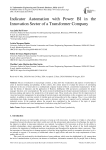
Indicator Automation with Power BI in the Innovation Sector of a Transformer Company
Ana Julia Dal Forno, Letícia Marques Bauler, Selene de Souza Siqueira Soares, Marilise Luiza Martins dos Reis Sayão
Статья научная
The use of indicators is increasingly common, as they allow the visualization and analysis of useful data to assist in decision-making and planning. In this context, this article aimed to evaluate the process of automating indicators in the area of innovation in a multinational company located in Brazil, a transformer manufacturer. To this end, the themes of indicators and the application of Business Intelligence (BI) and process automation for project manager functions were conceptualized. The action research methodology developed automated indicators to facilitate decision-making and improve the productivity of the project team. These results also allowed for the improvement of visual and systemic management, by presenting all current projects and information on the occupancy rate of each team member, in addition to real-time control of whether goals are being achieved in the company. Thus, it was evident that centralizing data helps managers make more assertive decisions and the case reported can be replicated to other industrial sectors. In the academic sphere, the research also contributed to the evolution of the topic of project integration, automation and visual management of indicators using the Power BI tool.
Бесплатно
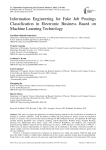
Markiian-Mykhailo Paprotskyi, Victoria Vysotska, Lyubomyr Chyrun, Yuriy Ushenko, Zhengbing Hu, Dmytro Uhryn
Статья научная
This study investigates the application of machine learning methods for the classification of fraudulent job postings in e-business platforms. Using the publicly available fake_job_postings.csv dataset, textual and categorical features of vacancies were processed and vectorised through TF-IDF, HashingVectorizer, and optimised TF-IDF. Eight machine learning algorithms were compared, including Logistic Regression, Random Forest, Gradient Boosting, Decision Tree, Multinomial Naive Bayes, Linear SVC, K-Nearest Neighbours, and XGBoost. The experiments demonstrate that XGBoost achieved the best performance (Accuracy = 0.990, Precision = 0.982, Recall = 0.998, F1 = 0.990) across all feature representations. Its superior results can be attributed to the ability of boosted ensembles to capture complex non-linear relationships in high-dimensional feature spaces while maintaining robustness against noise and class imbalance. However, it should be noted that the evaluation was performed on a single static dataset. While the high recall shows the model’s ability to reliably detect fraudulent ads in this context, questions remain about its generalisability. Fraud tactics evolve rapidly, and new job scams may significantly differ from patterns in the training data. This creates a potential risk of overfitting to dataset-specific features, which limits direct transfer to real-world scenarios without continuous retraining and monitoring. The practical contribution of the study is a reproducible framework that integrates text and categorical processing, vectorisation, hyperparameter optimisation, and comparative model benchmarking. Such a framework could be embedded into online job platforms to support automated filtering of suspicious ads. Still, its deployment requires additional measures: periodic retraining with updated data, integration with platform APIs, and the inclusion of explainability modules to ensure transparency and user trust. Overall, the research demonstrates that ensemble-based models, particularly XGBoost, offer strong potential for fraud detection in the e-business labour market. At the same time, further work is necessary to validate model robustness on unseen and evolving fraudulent job posting strategies, ensuring scalability and reliability in production environments.
Бесплатно
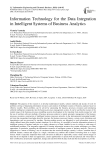
Information Technology for the Data Integration in Intelligent Systems of Business Analytics
Victoria Vysotska, Andrii Berko, Yevhen Burov, Dmytro Uhryn, Zhengbing Hu, Valentyna Dvorzhak
Статья научная
The purpose of the research is to develop mathematical models, solution methods and layouts of tools for problems solving of integrating information resources and creation of intelligent systems of business analytics based on effective models. These problems can be solved by automating the business processes execution and introducing artificial intelligence components into the business processes management systems. It can be said that the essence of the modern stage of the business processes modelling systems development is the transition from mainly manual (or with the use of auxiliary software) methods of business processes analysis to mainly automatic management of the business processes execution, construction of intelligent business processes networks in the interconnected conceptual models’ set form that encapsulate knowledge about the structure, the business processes features, system events, limitations and dependencies and are processed by machine. Decision-making powers are delegated to such information system in clearly defined (most often simple, routine) situations. So, in this way, it is possible to form the information resource of intelligent systems of business analytics as a single coherent set of data, suitable for use in solving a wide range of multifaceted problems. The integration approach of forming information resources has certain advantages over other approaches, in particular, regarding the information resources of intelligent systems of business analytics. The use of integration as a means of forming a set of consistent data has certain advantages, namely, it allows: combine data of different formats, content and origins in a single, consistent set; combine data without converting them to a single format, which is especially important when such conversion is difficult or impossible; creates virtual custom images of data that do not depend on their real appearance; creates opportunities to operate both real physical and virtual data in their combination; dynamically supplement, change and transform both the data itself and their descriptions; to provide uniform methods and technologies of perception and application of a large amount of various data.
Бесплатно
- О проекте
- Правообладателям
- Правила пользования
- Контакты
- Разработчик: ООО "Технологии мобильного чтения"
Государственная аккредитация IT: АО-20230321-12352390637-3 | Минцифры России - 2025 © SciUp.org — Платформа публикаций в области науки, технологий, медицины, образования и литературы. "SciUp" — зарегистрированный товарный знак. Все права защищены.

